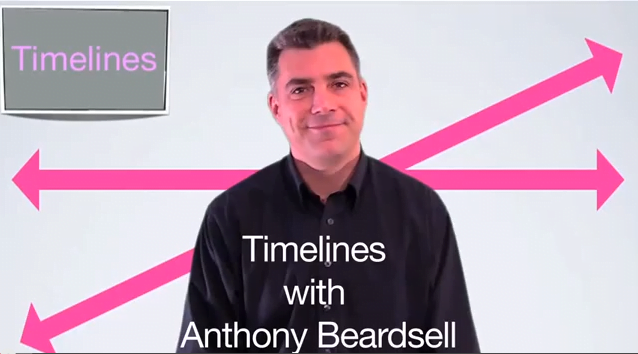A Timeline is a visual, linear experience of how someone codes and stores time. In NLP timeline is a term used to describe the way we internally represent time. We internally represent the past, present and future differently. Our ability to determine whether an event has happened in the past, is happening in the present, or is a future projection comes by matching the experience to our unique time line.
Timeline describes how we characterise chronological time in the space around us. Timeline work is an NLP Practitioner and NLP Master Practitioner subject, these processes are powerful and you are advised to attend an NLP Training before you do any of the NLP processes described below.
Strong emotions are generated way back in the past and the memories of similar events where the same emotion is generated are stored in a gestalt. The mind recognises (generalises) events in the present and assesses likely event patterns (through generalising) in the the future and the emotion recognised from the past is replicated in the present and even when thinking about the event in the future. Therefore there is a very good reason to do some work in clearing up the negative emotions in your past!
The video below is a demonstration for our online NLP practitioner training course, it show you how timeline work can help people eliminate negative emotions:
Eliciting a timeline
Method 1
‘If I were to ask your unconscious mind, where the past is, and where your future is, if I were to guess I would think that you may say, ‘its from right to left, or front to back, or up to down, or in some direction from you in relation to your body. It is not your conscious concept that i’m interested in, it’s your unconscious. So if I were to ask your unconscious mind where is your past, to what direction would you point?’
‘And, your future, what direction would you point if i asked your unconscious mind, where’s your future?’
Method 2
‘Can you remember something that happened 1 week ago
Good, as you do, can you notice where it comes from?’
Repeat for 1 month ago, 1 year ago, 5 years ago and 10 years ago
Now apply same to the future
Now ask ‘do you notice that this arrangement implies a line, or some linear arrangement of your memories?’
Basic timeline process
- Elicit timeline
- Find first event
- Go back on the line to just after the event occurred
- Go back further to directly over the event, looking down on it ask unconscious mind to take learnings. Ask client to tell you what they are.
- Go to just before the event. Ask ‘where are the emotions?’
- Float down inside the event, looking through own eyes. Ask ‘where are the emotions?’
- Go back to just before the event, above timeline.
- Come back to present.
- Break State
- Test
- Future Pace
Through-Time and In-Time
Through-time people will store their memories left to right or right to left or in any other way so that all time is in front of them. Time is continuous and uninterrupted.
An in-time person will prefer to code their memories from front to back, up to down, in a ‘V’ or any arrangement where part of the past, present or future is behind the plane of the eyes.
Shifting a timeline (To or from In-time, through-time)
This process is not recommended unless you have completed an NLP timeline training as it can create huge shifts in your personality. Some may be positive and some not. NLP Training with Excellence Assured offers training in NLP Timeline.
- Elicit timeline
- Clean up -ve emotions, limiting decisions
- Check ecology
- Rotate the timeline
- Re-associate in the present
- Lock it in place
- Test
- Future Pace
Temporal Submodalities
Where the sights, sounds and feelings associated with time are stored, and how.
Time code
Is the way that we store our memories (code things) in past, present and future.

